The Carboniferous is a geologic period and system of the Paleozoic that spans 60 million years from the end of the Devonian Period 358.9 million years ago (Mya), to the beginning of the Permian Period, 298.9 Mya. The name Carboniferous means "coal-bearing", from the Latin carbō ("coal") and ferō, and refers to the many coal beds formed globally during that time.
The PaleozoicEra is the earliest of three geologic eras of the Phanerozoic Eon. It is the longest of the Phanerozoic eras, lasting from 541 to 251.902 million years ago, and is subdivided into six geologic periods : the Cambrian, Ordovician, Silurian, Devonian, Carboniferous, and Permian. The Paleozoic comes after the Neoproterozoic Era of the Proterozoic Eon and is followed by the Mesozoic Era.

Crinoids are marine animals that make up the class Crinoidea, one of the classes of the phylum Echinodermata, which also includes the starfish, brittle stars, sea urchins and sea cucumbers. Those crinoids which, in their adult form, are attached to the sea bottom by a stalk are commonly called sea lilies, while the unstalked forms are called feather stars or comatulids, being members of the largest crinoid order, Comatulida.
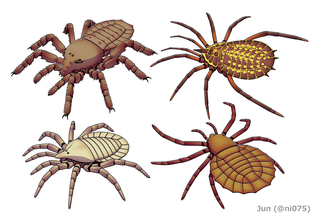
The order Trigonotarbida is a group of extinct arachnids whose fossil record extends from the late Silurian to the early Permian. These animals are known from several localities in Europe and North America, as well as a single record from Argentina. Trigonotarbids can be envisaged as spider-like arachnids, but without silk-producing spinnerets. They ranged in size from a few millimetres to a few centimetres in body length and had segmented abdomens (opisthosoma), with the dorsal exoskeleton (tergites) across the backs of the animals' abdomens, which were characteristically divided into three or five separate plates. Probably living as predators on other arthropods, some later trigonotarbid species were quite heavily armoured and protected themselves with spines and tubercles. About seventy species are currently known, with most fossils originating from the Carboniferous coal measures.

Actinocrinites is an extinct genus of crinoids.
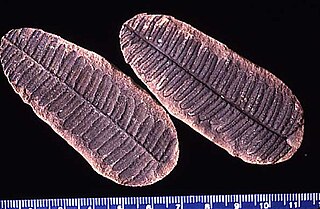
Pecopteris is a very common form genus of leaves. Most Pecopteris leaves and fronds are associated with the marattialean tree fern Psaronius. However, Pecopteris-type foliage also is borne on several filicalean ferns, and at least one seed fern. Pecopteris first appeared in the Devonian period, but flourished in the Carboniferous, especially the Pennsylvanian. Plants bearing these leaves became extinct in the Permian period, due to swamps disappearing and temperatures on Earth dropping.

Platyceras is a genus of extinct Paleozoic sea snails, marine gastropod mollusks in the family Platyceratidae. This genus is known from the Silurian to the Middle Triassic periods and especially abundant in the Devonian and Carboniferous. It is the type genus of the family Platyceratidae.
Aglaocrinus is an extinct species of crinoids in the Cladia order. It has been proposed that it was a blind, stationary (attached) suspension feeder the hard parts of which were composed of magnesium calcite. It has been discovered in 3 locations in North America.
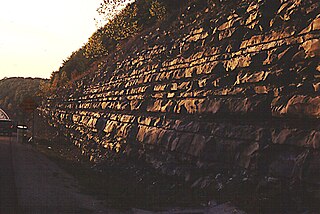
The Mississippian Borden Formation is a mapped bedrock unit in Kentucky, Indiana, Illinois, Ohio, West Virginia, and Tennessee. It has many members, which has led some geologists to consider it a group rather than a formation.
Fossils of many types of water-dwelling animals from the Devonian period are found in deposits in the U.S. state of Michigan. Among the more commonly occurring specimens are bryozoans, corals, crinoids, and brachiopods. Also found, but not so commonly, are armored fish called placoderms, snails, sharks, stromatolites, trilobites and blastoids.

Holopea is an extinct genus of fossil sea snails, Paleozoic gastropod mollusks in the family Holopeidae.

Gilbertsocrinus are an extinct genus of Paleozoic stalked crinoids.
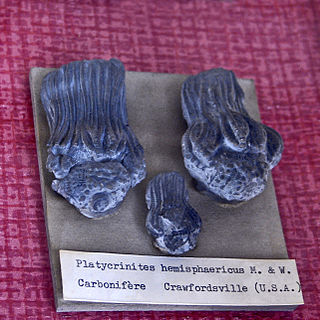
Platycrinitidae are an extinct family of Paleozoic stalked crinoids.

Neospirifer is an extinct genus of articulate brachiopod fossils belonging to the family Trigonotretidae.

Forbesiocrinus is an extinct genus of crinoids.
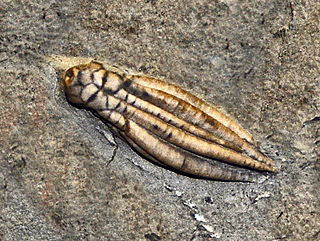
Scytalocrinus is an extinct genus of crinoids.

Adelophthalmidae is a family of eurypterids, an extinct group of aquatic arthropods. Adelophthalmidae is the only family classified as part of the superfamily Adelophthalmoidea, which in turn is classified within the infraorder Diploperculata in the suborder Eurypterina.
Crurithyris is an extinct genus of brachiopod belonging to the order Spiriferida and family Ambocoeliidae.
Lecythiocrinus is an extinct genus of sea lily belonging to the order Cyathocrinida and family Codiacrinidae. Species of this genus have been found in Pennsylvanian beds in Australia and North America.













